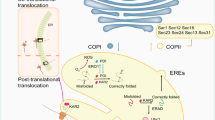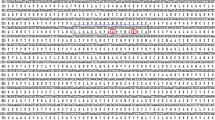Abstract
The expression of heterologous proteins may exert severe stress on the host cells at different levels. Protein folding and disulfide bond formation were identified as rate-limited steps in recombinant protein secretion in yeast cells. For the production of β-glucosidase in Pichia pastoris, final β-glucosidase activity reached 1,749 U/mL after fermentation optimization in a 3 L bioreactor, while the specific activity decreased from 620 to 467 U/mg, indicating a potential protein misfolding. To solve this problem, protein disulfide isomerase, a chaperone protein which may effectively regulate disulfide bond formation and protein folding, was co-expressed with β-glucosidase. In the co-expression system, a β-glucosidase production level of 2,553 U/mL was achieved and the specific activity of the enzyme reached 721 U/mg, which is 1.54 fold that of the control.
Similar content being viewed by others
References
Chantasingh, D. (2006) Cloning, expression, and characterization of a xylanase 10 from Aspergillus terreus (BCC129) in Pichia pastoris. Protein Expr. Purif. 46: 143–149.
Cereghino, J. L. and J. M. Cregg (2000) Heterologous protein expression in the methylotrophic yeast Pichia pastoris. FEMS Microbiol. Rev. 24: 45–66.
Chantasingh, D. (2006) Cloning, expression, and characterization of a xylanase 10 from Aspergillus terreus (BCC129) in Pichia pastoris. Protein Expr. Purif. 46: 143–149.
Zhang, W. (2006) Enhanced secretion of heterologous proteins in Pichia pastoris following overexpression of Saccharomyces cerevisiae chaperone proteins. Biotechnol. Prog. 22: 1090–1095.
Hohenblum, H. (2004) Effects of gene dosage, promoters, and substrates on unfolded protein stress of recombinant Pichia pastoris. Biotechnol. Bioeng. 85: 367–375.
Agashe, V. R. and F. U. Hartl (2000) Roles of molecular chaperones in cytoplasmic protein folding. Semin. Cell Dev. Biol. 11: 15–25.
Qu Lin, L. J. -Y. and Z. Qi (2010) Effect of coexpressing protein disulfide isomerase on expression of IFNβ-HSA fusion protein in Pichia pastoris. Chin. J. Biologicals. 23: 346–349.
Xu, P. (2005) Analysis of unfolded protein response during single-chain antibody expression in Saccaromyces cerevisiae reveals different roles for BiP and PDI in folding. Metab. Eng. 7: 269–279.
Powers, S. L. and A. S. Robinson (2007) PDI improves secretion of redox-inactive beta-glucosidase. Biotechnol. Prog. 23: 364–369.
Sinnott, M. L. (1990) Catalytic mechanisms of enzymic glycosyl transfer. American Chem. Society 90: 1171–1202.
Duff, S. J. B. and W. D. Murray. (1996) Bioconversion of forest products industry waste cellulosics to fuel ethanol: A review. Bioresource Technol. 55: l–33.
Sheehan, J. and M. Himmel (1999) Enzymes, energy, and the environment: A strategic perspective on the US Department of Energy’s research and development activities for bioethanol. Biotechnol. Prog. 15: 817–827.
Vulfson, E. N., R. Patel, and B. Law (1990) Alkyl glucoside synthesis in a water-organic two-phase system. Biotechnol.Lett. 12: 397–402.
Heather, F. and R. E. H. Seidle (2005) Transglusidic reactions of the Aspergillus niger Family 3 β-glucosidase Qualitative and quantitative analyses and evidence that the transglucosidic rate is independent of pH. Arch. Biochem. Biophys. 436: 254–264.
Lingling Liu, S. Z. (2009) Production of gentiooligosaccharide by recombinant β-glucosidase. Acta Mcrobiol. Sinica. 49: 597–602.
Joseph Sambrook, D. W. R (2001) Molecular cloning: A laboratory manual. 3rd ed. Cold Spring Harbor Laboratory Press, Cold Spring Harbor, NY, USA.
Jason, D., B. C. T. Smith, and A. S. Robinson (2003) Protein disulfide isomerase. But not binding protein, overexpression enhances secretion of a Non-disulfide-bonded protein in yeast. Biotechnol. Bioeng. 85: 340–350.
Shu, W. R. (2007) Method of producing recombinant Aspergillus niger β-glucosidase and an aroma spreading plant. US Patent 7,223,902.
Salmon, J. -M. (2006) Interactions between yeast, oxygen and polyphenols during alcoholic fermentations: Practical implications. Food Sci. Technol. 39: 959–965.
Perrone, G. G., S. X. Tan, and I. W. Dawes (2008) Reactive oxygen species and yeast apoptosis. Biochim. Biophys. Acta 1783: 1354–1368.
Wang, Z. (2009) Enhancement of cell viability and alkaline polygalacturonate lyase production by sorbitol co-feeding with methanol in Pichia pastoris fermentation. Bioresour. Technol. 101: 1318–1323.
Joan Lin Cereghino, J. M. C. (2000) Heterologous protein expression in the methylotrophic yeast Pichia pastoris. FEMS Microbiol. Rev. 24: 45–66.
Author information
Authors and Affiliations
Corresponding author
Rights and permissions
About this article
Cite this article
Zhang, Jh., Wu, D., Chen, J. et al. Enhancing functional expression of β-glucosidase in Pichia pastoris by co-expressing protein disulfide isomerase. Biotechnol Bioproc E 16, 1196–1200 (2011). https://doi.org/10.1007/s12257-011-0136-1
Received:
Revised:
Accepted:
Published:
Issue Date:
DOI: https://doi.org/10.1007/s12257-011-0136-1




